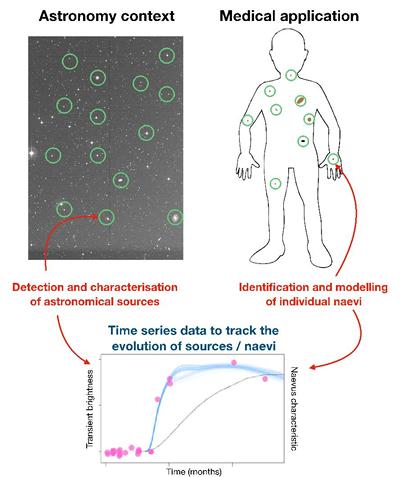
Astrophysics and dermatology are colliding through a new research project led by the University of Southampton - with potentially lifesaving consequences.
The project, dubbed MoleGazer, will take algorithms used for detecting exploding stars in astronomical imaging data and develop them to be used to spot changes in skin moles and, therefore, detect skin cancer.
Skin cancer is one of the most common cancers in the UK. According to Cancer Research UK there are 16,000 new cases of melanoma and 147,000 of new cases of non-melanoma skin cancer diagnosed each year.
MoleGazer, led by Professor Mark Sullivan, Head of the School of Physics and Astronomy at the University, and Postdoctoral Researcher Mathew Smith, has been awarded a Proof of Concept Grant from the European Research Council (ERC). It is the first time the University has won such a grant.
Professor Sullivan said: "The idea is to take astronomy techniques we have developed and apply them to the detection and early warning signs for skin cancer."
Professor Sullivan was awarded an ERC Consolidator Grant in 2014 for his research on the explosive death of stars, called supernovae.

"Supernovae change over time – about three weeks after explosion they reach peak brightness, then they gradually fade," explained Professor Sullivan.
"We take images of the sky over a period of time, and compare them to detect supernovae. In order to do this, we have developed Artificial Intelligence algorithms to track changes in images. We take tens of thousands of these images and the supernova signature is very subtle – so it would be impossible for humans to analyse them all."
Professor Sullivan and Dr Smith, alongside Dr Rubeta Matin, Consultant Dermatologist at Oxford University Hospitals NHS Foundation Trust, are now adapting the automated techniques to look at moles.
Currently, patients at high risk of developing skin cancer are photographed at regular intervals and a consultant visually compares images to detect changes. MoleGazer could automate this process, potentially leading to earlier diagnoses and improved survival rates.
"It's a really exciting project that came along from nowhere," added Professor Sullivan. "It also highlights the importance of blue sky science – curiosity-driven scientific research will always have a fundamentally important role to play."
The Proof of Concept Grant is for €150,000 over 18 months, starting in April.






